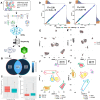scPipe: an extended preprocessing pipeline for comprehensive single-cell ATAC-Seq data integration in R/Bioconductor
- PMID: 38046273
- PMCID: PMC10689045
- DOI: 10.1093/nargab/lqad105
scPipe: an extended preprocessing pipeline for comprehensive single-cell ATAC-Seq data integration in R/Bioconductor
Abstract
scPipe is a flexible R/Bioconductor package originally developed to analyse platform-independent single-cell RNA-Seq data. To expand its preprocessing capability to accommodate new single-cell technologies, we further developed scPipe to handle single-cell ATAC-Seq and multi-modal (RNA-Seq and ATAC-Seq) data. After executing multiple data cleaning steps to remove duplicated reads, low abundance features and cells of poor quality, a SingleCellExperiment object is created that contains a sparse count matrix with features of interest in the rows and cells in the columns. Quality control information (e.g. counts per cell, features per cell, total number of fragments, fraction of fragments per peak) and any relevant feature annotations are stored as metadata. We demonstrate that scPipe can efficiently identify 'true' cells and provides flexibility for the user to fine-tune the quality control thresholds using various feature and cell-based metrics collected during data preprocessing. Researchers can then take advantage of various downstream single-cell tools available in Bioconductor for further analysis of scATAC-Seq data such as dimensionality reduction, clustering, motif enrichment, differential accessibility and cis-regulatory network analysis. The scPipe package enables a complete beginning-to-end pipeline for single-cell ATAC-Seq and RNA-Seq data analysis in R.
© The Author(s) 2023. Published by Oxford University Press on behalf of NAR Genomics and Bioinformatics.
Figures


References
-
- Satpathy A.T., Granja J.M., Yost K.E., Qi Y., Meschi F., McDermott G.P., Olsen B.N., Mumbach M.R., Pierce S.E., Corces M.R. et al. . Massively parallel single-cell chromatin landscapes of human immune cell development and intratumoral T cell exhaustion. Nat. Biotechnol. 2019; 37:925–936. - PMC - PubMed
LinkOut - more resources
Full Text Sources
Molecular Biology Databases

